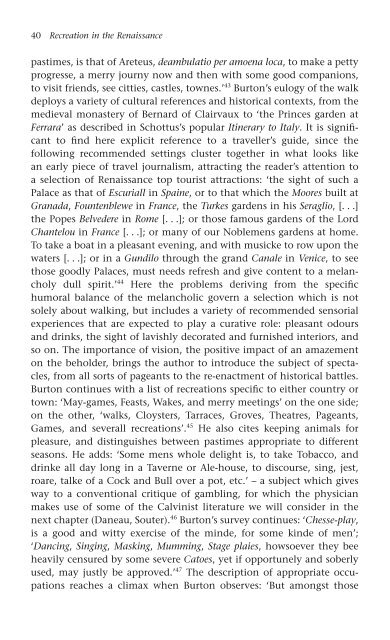Recreation in the Renaissance
Recreation in the Renaissance
Recreation in the Renaissance
- No tags were found...
You also want an ePaper? Increase the reach of your titles
YUMPU automatically turns print PDFs into web optimized ePapers that Google loves.
40 <strong>Recreation</strong> <strong>in</strong> <strong>the</strong> <strong>Renaissance</strong><br />
pastimes, is that of Areteus, deambulatio per amoena loca, to make a petty<br />
progresse, a merry journy now and <strong>the</strong>n with some good companions,<br />
to visit friends, see citties, castles, townes.’ 43 Burton’s eulogy of <strong>the</strong> walk<br />
deploys a variety of cultural references and historical contexts, from <strong>the</strong><br />
medieval monastery of Bernard of Clairvaux to ‘<strong>the</strong> Pr<strong>in</strong>ces garden at<br />
Ferrara’ as described <strong>in</strong> Schottus’s popular It<strong>in</strong>erary to Italy. It is significant<br />
to f<strong>in</strong>d here explicit reference to a traveller’s guide, s<strong>in</strong>ce <strong>the</strong><br />
follow<strong>in</strong>g recommended sett<strong>in</strong>gs cluster toge<strong>the</strong>r <strong>in</strong> what looks like<br />
an early piece of travel journalism, attract<strong>in</strong>g <strong>the</strong> reader’s attention to<br />
a selection of <strong>Renaissance</strong> top tourist attractions: ‘<strong>the</strong> sight of such a<br />
Palace as that of Escuriall <strong>in</strong> Spa<strong>in</strong>e, or to that which <strong>the</strong> Moores built at<br />
Granada, Fountenblewe <strong>in</strong> France, <strong>the</strong> Turkes gardens <strong>in</strong> his Seraglio, [. . .]<br />
<strong>the</strong> Popes Belvedere <strong>in</strong> Rome [. . .]; or those famous gardens of <strong>the</strong> Lord<br />
Chantelou <strong>in</strong> France [. . .]; or many of our Noblemens gardens at home.<br />
To take a boat <strong>in</strong> a pleasant even<strong>in</strong>g, and with musicke to row upon <strong>the</strong><br />
waters [. . .]; or <strong>in</strong> a Gundilo through <strong>the</strong> grand Canale <strong>in</strong> Venice, to see<br />
those goodly Palaces, must needs refresh and give content to a melancholy<br />
dull spirit.’ 44 Here <strong>the</strong> problems deriv<strong>in</strong>g from <strong>the</strong> specific<br />
humoral balance of <strong>the</strong> melancholic govern a selection which is not<br />
solely about walk<strong>in</strong>g, but <strong>in</strong>cludes a variety of recommended sensorial<br />
experiences that are expected to play a curative role: pleasant odours<br />
and dr<strong>in</strong>ks, <strong>the</strong> sight of lavishly decorated and furnished <strong>in</strong>teriors, and<br />
so on. The importance of vision, <strong>the</strong> positive impact of an amazement<br />
on <strong>the</strong> beholder, br<strong>in</strong>gs <strong>the</strong> author to <strong>in</strong>troduce <strong>the</strong> subject of spectacles,<br />
from all sorts of pageants to <strong>the</strong> re-enactment of historical battles.<br />
Burton cont<strong>in</strong>ues with a list of recreations specific to ei<strong>the</strong>r country or<br />
town: ‘May-games, Feasts, Wakes, and merry meet<strong>in</strong>gs’ on <strong>the</strong> one side;<br />
on <strong>the</strong> o<strong>the</strong>r, ‘walks, Cloysters, Tarraces, Groves, Theatres, Pageants,<br />
Games, and severall recreations’. 45 He also cites keep<strong>in</strong>g animals for<br />
pleasure, and dist<strong>in</strong>guishes between pastimes appropriate to different<br />
seasons. He adds: ‘Some mens whole delight is, to take Tobacco, and<br />
dr<strong>in</strong>ke all day long <strong>in</strong> a Taverne or Ale-house, to discourse, s<strong>in</strong>g, jest,<br />
roare, talke of a Cock and Bull over a pot, etc.’ – a subject which gives<br />
way to a conventional critique of gambl<strong>in</strong>g, for which <strong>the</strong> physician<br />
makes use of some of <strong>the</strong> Calv<strong>in</strong>ist literature we will consider <strong>in</strong> <strong>the</strong><br />
next chapter (Daneau, Souter). 46 Burton’s survey cont<strong>in</strong>ues: ‘Chesse-play,<br />
is a good and witty exercise of <strong>the</strong> m<strong>in</strong>de, for some k<strong>in</strong>de of men’;<br />
‘Danc<strong>in</strong>g, S<strong>in</strong>g<strong>in</strong>g, Mask<strong>in</strong>g, Mumm<strong>in</strong>g, Stage plaies, howsoever <strong>the</strong>y bee<br />
heavily censured by some severe Catoes, yet if opportunely and soberly<br />
used, may justly be approved.’ 47 The description of appropriate occupations<br />
reaches a climax when Burton observes: ‘But amongst those










